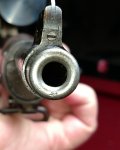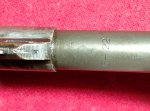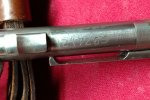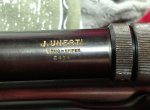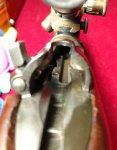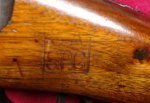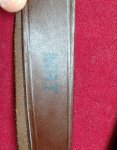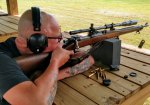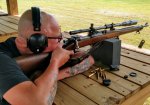- Thread starter [email protected]
- Start date
You are using an out of date browser. It may not display this or other websites correctly.
You should upgrade or use an alternative browser.
You should upgrade or use an alternative browser.
Yes we do! Thanks for posting that up! Now, get ready to answer a bunch of questions about it.Just wanted to take it out and show it to folks that would appreciate it.
1. How well does it shoot?
2. How easily does the scope return to battery?
3. Have you ever taken off the scope and shot it with irons? if so how far?
4. If you feel up to it can you provide detail (closer) pics if needed for the follow-on crowd?
Cplnorton will be able to discuss with a strong research ability.
Its a beautiful rifle.
Do you have more pictures of details.....serial on bolt, bolt raceways, muzzle, serial number.
What was the history of it?
Its a beautiful rifle.
Do you have more pictures of details.....serial on bolt, bolt raceways, muzzle, serial number.
What was the history of it?
Oh man! That is sooo cool! Thank you for posting! I too would love to hear more about it!
1. I haven't shot it (yet). It's too beautiful.Yes we do! Thanks for posting that up! Now, get ready to answer a bunch of questions about it.
1. How well does it shoot?
2. How easily does the scope return to battery?
3. Have you ever taken off the scope and shot it with irons? if so how far?
4. If you feel up to it can you provide detail (closer) pics if needed for the follow-on crowd?
2. Scope turrets turn ok.
3. No.
4. I will send more pix.
2. How easily does the scope return to battery?
With the recoil spring on there, it won't move a lot as the spring returns it to the rear position. With the spring removed and you fire these, they actually slide forward a lot. Well the scope doesn't actually move, it's the rifle, but that is another story.
But usually when I shoot mine, by the fourth or fifth shot the scope is all the way in the forward position, and you can't see anything in the sight picture. The original 8X Unertl scopes aren't the best sniper scope. They are great for target shooting at a range, but the field of view at a 100 yards is only about 11 feet. So it's easy to get tunnel vision looking through one. So when the scope is in the forward position your sight picture is even worse and you really don't see anything but the center of the cross hairs.
In fact it's so easy to get tunnel vision that in WWII, the Marines actually operated in a 3 man sniper team. You had the shooter, spotter, and the third man protected their six while they were scanning for targets. The third man many times was armed with a Thompson.
The Marines fired these rifles without the recoil springs on the scopes, because the recoil of the M2 round with the spring on it, would eventually cause the scope to shake apart. So the MArines did not have a recoil spring on their centerfire rifles. You do see a lot of original USMC Unertl scopes with them though, but that is because they were used a lot on .22 training rifles. The Marines did not make many of the 1903A1 Unertl snipers to begin with, and many scopes ended up on rim-fire trainer rifles post WWII.
That is probably also why you see original USMC Unertl scopes that have been reworked into higher magnifications as well. Or at least that is my theory on why you see it, as you always see higher magnifications used with the rimfire trainers.
Attachments
Cplnorton will be able to discuss with a strong research ability.
Its a beautiful rifle.
Do you have more pictures of details.....serial on bolt, bolt raceways, muzzle, serial number.
What was the history of it?
The seller specializes in rare collectables. This rifle came from an estate of a retired Col. Thats about all I know.
SN on bolt matches SN on receiver.
As far as scope returning to battery, I haven't shot it but the recoil spring works pretty good just fiddling around simulating recoil. I do intend to shoot it (someday).Yes we do! Thanks for posting that up! Now, get ready to answer a bunch of questions about it.
1. How well does it shoot?
2. How easily does the scope return to battery?
3. Have you ever taken off the scope and shot it with irons? if so how far?
4. If you feel up to it can you provide detail (closer) pics if needed for the follow-on crowd?
As far as scope returning to battery, I haven't shot it but the recoil spring works pretty good just fiddling around simulating recoil. I do intend to shoot it (someday).Yes we do! Thanks for posting that up! Now, get ready to answer a bunch of questions about it.
1. How well does it shoot?
2. How easily does the scope return to battery?
3. Have you ever taken off the scope and shot it with irons? if so how far?
4. If you feel up to it can you provide detail (closer) pics if needed for the follow-on crowd?
From what I'm told; the services weren't prepared for WWII. The Marines recalled all their NM rifles from Divisions, etc. They were sent to the Philadelphia Naval Yard where they were repaired & fitted with the 8X scope and sent to the Pacific. One thing to look for was a pre-war, star gauged bbl, NM sights, polished bolts, checked butt plate, etc.
Sounds like you did some research beforehand, good on you.
Nice rifle.
Most of the snipers had the spring assembly removed because under 30-06 recoil it becomes a detriment to the life of the reticle cell.
With the recoil spring in place the scope is subject to first the shock of recoil, somewhat subdued by the spring, than probably just as harmful there is the counter shock of the spring powered return to battery.
Without the spring the scope actually floats in space and slips through its mounts while rifle and shooter absorb the recoil force.
Thats one theory and it probably has some validity with a scope that was intended to be used in combat but I dont think Unertl designed his gear with the intent they only be mounted on .22 caliber rifles. Lots of other shooters used these scopes on 30-06 or equally punishing rifles and never had an issue.
Another theory I read about that seems to make more sense is that the removal of the spring assembly eliminated a maintenance nightmare.
Can you imagine the spring assembly filled with coral reef sand? Trying to clean it out, bits of sand getting wedge in the in the spring keepers. Than what happens under recoil as the sand is ground back and forth with the spring into the tube.
Its probably bad enough what sand and debris did in the limited contact areas of the front and rear mounts.
Nice rifle.
Most of the snipers had the spring assembly removed because under 30-06 recoil it becomes a detriment to the life of the reticle cell.
With the recoil spring in place the scope is subject to first the shock of recoil, somewhat subdued by the spring, than probably just as harmful there is the counter shock of the spring powered return to battery.
Without the spring the scope actually floats in space and slips through its mounts while rifle and shooter absorb the recoil force.
Thats one theory and it probably has some validity with a scope that was intended to be used in combat but I dont think Unertl designed his gear with the intent they only be mounted on .22 caliber rifles. Lots of other shooters used these scopes on 30-06 or equally punishing rifles and never had an issue.
Another theory I read about that seems to make more sense is that the removal of the spring assembly eliminated a maintenance nightmare.
Can you imagine the spring assembly filled with coral reef sand? Trying to clean it out, bits of sand getting wedge in the in the spring keepers. Than what happens under recoil as the sand is ground back and forth with the spring into the tube.
Its probably bad enough what sand and debris did in the limited contact areas of the front and rear mounts.
Another "fact" I "heard" was that quite a few USMC scopes never made it beyond the armorers supply. Yes they bought over a thousand of them but not each and every one made it on a team rifle or a sniper 03/Win Model 70.
Possible your scope was new/slightly used/from a training school and never had the spring assembly removed.
Removing it is pretty easy with just two steps that make my heart beat faster but taking it off would not really be necessary as the rifle is its own history.
Possible your scope was new/slightly used/from a training school and never had the spring assembly removed.
Removing it is pretty easy with just two steps that make my heart beat faster but taking it off would not really be necessary as the rifle is its own history.
Another "fact" I "heard" was that quite a few USMC scopes never made it beyond the armorers supply. Yes they bought over a thousand of them but not each and every one made it on a team rifle or a sniper 03/Win Model 70.
Possible your scope was new/slightly used/from a training school and never had the spring assembly removed.
Removing it is pretty easy with just two steps that make my heart beat faster but taking it off would not really be necessary as the rifle is its own history.
The Marines bought 1750 scopes, but it appears very few actual rifles were built. The initial shipment to the Pacific was a 150 rifles and an additional 100 appears to be shipped after the first 150. All shipped by mid 1943.
Which that 250 rifles was more than enough rifles for the four Marine Divisions who had them in the war. As each Division had about 50 rifles.
The Unerl sniper program was supposed to be a huge success but conflicting early reports of the WRA A5 sniper in the Pacific and just the early jungle fighting was just too close for a sniper rifle. So the early reports said a semi automatic M1 was just more effective.
So the Unertl program was really cancelled from the very beginning. If it wasn't for the fact that they remained in the field and were used to great extent on the islands of Saipan and especially Okinawa where a 1000 yard capable sniper could stretch it's legs. They probalby would have been considered pointless.
All rifles started as a National Match team rifle. All were housed at the Philly Depot in the off season. At the end of each season the rifles were returned to the depot and checked over. The life span of the barrels on these rifles was very low. Usually they replaced them at about a 1000 rounds. Once the barrel was worn out, the Marines replaced them with a standard barrel. Star marked barrels were not used in Replacement. Once replaced the rifles would be known as Marine Special Target rifles, and were not used on the rifle teams any longer. Instead they were used for Marine Diviisional Matches such as the Elliot Cup.
The Marines were constantly buying new NM rifles for the teams, as the teams mostly just used new rifles in competition. Usually they bought them every couple years and sometimes there were years they bought rifles back to back. It was mostly if they had the budget or not.
We actually found the purchase orders of the NM rifles from 1919 to 1940. Most Unertl Snipers fall into the last two purchases, the 1937 and 1940 shipments.
Since the Unertl program was really cancelled from the beginning, and the Marines had paid for the Unertl socpes already, they used the scopes on anything. Usually the .22 trainer rifles got a lot of them. But as PMClaine said, the vast majority sat in storage and were never used. Most Unertl scopes you run across today look basically NOS.
Very nice rifle. They are fun to compete with too (mine is a replica, so no guilt in shooting it),
https://www.snipershide.com/shootin...age-sniper-match-vsm-pics-from-match.6885147/
https://www.snipershide.com/shootin...age-sniper-match-vsm-pics-from-match.6885147/
Very, very nice rifle and thanks for posting!
Cheers,
Sirhr
Cheers,
Sirhr
Another "fact" I "heard" was that quite a few USMC scopes never made it beyond the armorers supply. Yes they bought over a thousand of them but not each and every one made it on a team rifle or a sniper 03/Win Model 70.
Possible your scope was new/slightly used/from a training school and never had the spring assembly removed.
Removing it is pretty easy with just two steps that make my heart beat faster but taking it off would not really be necessary as the rifle is its own history.
That makes a whole lot of sense. Never thought about all that sand. I imagine sand hazard deminished a lot once they got a little inland.Sounds like you did some research beforehand, good on you.
Nice rifle.
Most of the snipers had the spring assembly removed because under 30-06 recoil it becomes a detriment to the life of the reticle cell.
With the recoil spring in place the scope is subject to first the shock of recoil, somewhat subdued by the spring, than probably just as harmful there is the counter shock of the spring powered return to battery.
Without the spring the scope actually floats in space and slips through its mounts while rifle and shooter absorb the recoil force.
Thats one theory and it probably has some validity with a scope that was intended to be used in combat but I dont think Unertl designed his gear with the intent they only be mounted on .22 caliber rifles. Lots of other shooters used these scopes on 30-06 or equally punishing rifles and never had an issue.
Another theory I read about that seems to make more sense is that the removal of the spring assembly eliminated a maintenance nightmare.
Can you imagine the spring assembly filled with coral reef sand? Trying to clean it out, bits of sand getting wedge in the in the spring keepers. Than what happens under recoil as the sand is ground back and forth with the spring into the tube.
Its probably bad enough what sand and debris did in the limited contact areas of the front and rear mounts.
But once inland you would have branches, vines, etc that could easily ruin the spring anyway....That makes a whole lot of sense. Never thought about all that sand. I imagine sand hazard deminished a lot once they got a little inland.
I really have no interest in shooting it due to it's age and condition. But I'm going to pick up my newly built rifle near Ft Stewart tomorrow and the armor is taking me to a range to zero it. So I am taking this one too in case time permits.Very nice rifle. They are fun to compete with too (mine is a replica, so no guilt in shooting it),
https://www.snipershide.com/shootin...age-sniper-match-vsm-pics-from-match.6885147/
Sweet Rifle! Thank you for posting this!!
DW
DW
That makes a whole lot of sense. Never thought about all that sand. I imagine sand hazard deminished a lot once they got a little inland.
Not on Pacific Islands. sand was everywhere and if not sand dirt, if not dirt banyan leaves, if not banyan leaves insects...........
Okinawa 1977-78Not on Pacific Islands. sand was everywhere and if not sand dirt, if not dirt banyan leaves, if not banyan leaves insects...........
Okinawa 1977-78
So than you know real "jungle" is a living, breathing thing that consumes all that enters in.
I still have what the jungle gave me....So than you know real "jungle" is a living, breathing thing that consumes all that enters in.
#2
#1: I took it out today and shot about a dozen ro
#2: Sucky. I didn't think to put a little greese on the scope before shooting it today.Yes we do! Thanks for posting that up! Now, get ready to answer a bunch of questions about it.
1. How well does it shoot?
2. How easily does the scope return to battery?
3. Have you ever taken off the scope and shot it with irons? if so how far?
4. If you feel up to it can you provide detail (closer) pics if needed for the follow-on crowd?
#1: I took it out today and shot about a dozen ro
#1: Decided to take it to the range today. Shot fantastic. Held a tight group @100 yards.
#2: Sucky. Shoulda thought to greese it a points of contact.
#2: Sucky. Shoulda thought to greese it a points of contact.
Video
This is what positiion the scope is in, usually after 4 or 5 shots without the spring. It will be completely in the forward position.
The Marine snipers were trained to pull the scope back on every shot, just in a fluid motion just like you cycle the bolt.
This rifle is a Marine Special target rifle, a rebarreled NM by the Marines. It would have initially been in the 1935 shipment of 100 NM rifles to the Marines, or the 1936 shipment of 150. As was common most of these team rifles didn't make more than a couple seasons before needing re-barreled, so this one was probably rebarreled at the end of the 1939 or possibly the 1940 season. Though it's very likely it would have been the end of the 1939 season as it seems there was a mass rebarreling of the NM rifles by the Marines around this time. Probably because in the 1940 season the Marines bought their first M1 Garands for the teams and if the 1941 NM season had taken place, all competition would have been with the Garand.
As with many of the photos of these rifles you see in actual combat, the scope is often many times in this forward position. My thought is two things, they are firing so fast they don't have time to pull it back, or two, when you have it in this position it almost acts like a red dot sight. In the fact that the only thing you see is the center crosshairs on a target. So with it this far forward you would be able to scan for targets and then quick put the cross hairs on them. In a jungle enviroment when most shots were less than a 100 yards, I could see this being a viable solution for the 8x scope.

The Marine snipers were trained to pull the scope back on every shot, just in a fluid motion just like you cycle the bolt.
This rifle is a Marine Special target rifle, a rebarreled NM by the Marines. It would have initially been in the 1935 shipment of 100 NM rifles to the Marines, or the 1936 shipment of 150. As was common most of these team rifles didn't make more than a couple seasons before needing re-barreled, so this one was probably rebarreled at the end of the 1939 or possibly the 1940 season. Though it's very likely it would have been the end of the 1939 season as it seems there was a mass rebarreling of the NM rifles by the Marines around this time. Probably because in the 1940 season the Marines bought their first M1 Garands for the teams and if the 1941 NM season had taken place, all competition would have been with the Garand.
As with many of the photos of these rifles you see in actual combat, the scope is often many times in this forward position. My thought is two things, they are firing so fast they don't have time to pull it back, or two, when you have it in this position it almost acts like a red dot sight. In the fact that the only thing you see is the center crosshairs on a target. So with it this far forward you would be able to scan for targets and then quick put the cross hairs on them. In a jungle enviroment when most shots were less than a 100 yards, I could see this being a viable solution for the 8x scope.
Attachments
I kept forgetting to pull the scope back into battery. Didn't seem to affect my group thought. So when you state "this rifle"; are you giving me history on MY rifle or the one in the photo you shared?This is what positiion the scope is in, usually after 4 or 5 shots without the spring. It will be completely in the forward position.
The Marine snipers were trained to pull the scope back on every shot, just in a fluid motion just like you cycle the bolt.
This rifle is a Marine Special target rifle, a rebarreled NM by the Marines. It would have initially been in the 1935 shipment of 100 NM rifles to the Marines, or the 1936 shipment of 150. As was common most of these team rifles didn't make more than a couple seasons before needing re-barreled, so this one was probably rebarreled at the end of the 1939 or possibly the 1940 season. Though it's very likely it would have been the end of the 1939 season as it seems there was a mass rebarreling of the NM rifles by the Marines around this time. Probably because in the 1940 season the Marines bought their first M1 Garands for the teams and if the 1941 NM season had taken place, all competition would have been with the Garand.
As with many of the photos of these rifles you see in actual combat, the scope is often many times in this forward position. My thought is two things, they are firing so fast they don't have time to pull it back, or two, when you have it in this position it almost acts like a red dot sight. In the fact that the only thing you see is the center crosshairs on a target. So with it this far forward you would be able to scan for targets and then quick put the cross hairs on them. In a jungle enviroment when most shots were less than a 100 yards, I could see this being a viable solution for the 8x scope.
View attachment 6928857
This is what positiion the scope is in, usually after 4 or 5 shots without the spring. It will be completely in the forward position.
The Marine snipers were trained to pull the scope back on every shot, just in a fluid motion just like you cycle the bolt.
This rifle is a Marine Special target rifle, a rebarreled NM by the Marines. It would have initially been in the 1935 shipment of 100 NM rifles to the Marines, or the 1936 shipment of 150. As was common most of these team rifles didn't make more than a couple seasons before needing re-barreled, so this one was probably rebarreled at the end of the 1939 or possibly the 1940 season. Though it's very likely it would have been the end of the 1939 season as it seems there was a mass rebarreling of the NM rifles by the Marines around this time. Probably because in the 1940 season the Marines bought their first M1 Garands for the teams and if the 1941 NM season had taken place, all competition would have been with the Garand.
As with many of the photos of these rifles you see in actual combat, the scope is often many times in this forward position. My thought is two things, they are firing so fast they don't have time to pull it back, or two, when you have it in this position it almost acts like a red dot sight. In the fact that the only thing you see is the center crosshairs on a target. So with it this far forward you would be able to scan for targets and then quick put the cross hairs on them. In a jungle enviroment when most shots were less than a 100 yards, I could see this being a viable solution for the 8x scope.
View attachment 6928857
That's why they needed the second spring clamp.....one more shot and the front mount will fall off the Pope rib and be riding the tube.
I kept forgetting to pull the scope back into battery. Didn't seem to affect my group thought. So when you state "this rifle"; are you giving me history on MY rifle or the one in the photo you shared?
No the point of impact isn't changed on these scopes no matter the posiiton, just mostly the eye relief and sight picture.
In fact I have a killer document somewhere where John Unertl was trying to sell these scopes to the Marines and was showing one to them. He was questioned on how they would handle abuse and still retain zero. John pulled the scope off the rifle, walked over and took a tent stake and beat it into the ground with the Unertl scope being used as a hammer. He then put it back onto the rifle and shot it to show them it held zero.
I don't know where that doc is in the piles, but I have been looking for it. I always thought that was such an awesome story.
But no I was referring to the rifle in my picture. Several years ago we thought a lot of the info was wrong on these rifles in the books, so we went back to the National Archives and pulled out thousands of documents that have never been published on them. Many weren't released to the Archives till 2012.
The really cool find, we found the team records of when these rifles were just NM rifles and not snipers. So we found all the years they actually bought NM Rifles, and all they did to them while on the teams. It provided just a ton of new info that has never been published and proof on how to authenticate them.
Some of this research is left out, but a lot is public at Tim's website.
https://usmcweaponry.com/usmc-national-match-m1903s-m1903a1-unertl-sniper-rifle/
Video
Awesome video! Looks like a fun rifle.
There is a very good article in the USMC 1941 sniper in this month's Garand Collectors Assoc magazine. Three important things the author points out. All USMC snipers were required to have their bolts blued before issue. They all had the recoil spring removed from the scope and they were all from existing stocks of match and National match rifles.
With a shiny bolt and a recoil spring you rifle could have been a National Match. The USMC used them well into the 50's and sold a few of them to team shooters when they disposed of them. I have seen one with a USMC marked Lyman Super Target Spot that a former team Captain brought home in the late 50's, it shot extremely well.
With a shiny bolt and a recoil spring you rifle could have been a National Match. The USMC used them well into the 50's and sold a few of them to team shooters when they disposed of them. I have seen one with a USMC marked Lyman Super Target Spot that a former team Captain brought home in the late 50's, it shot extremely well.
Similar threads
- Replies
- 8
- Views
- 1K

